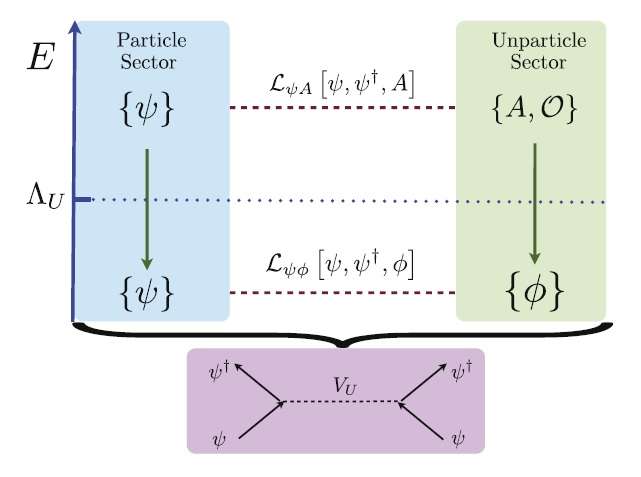April 7, 2015 feature
Unparticles may provide a new path to superconductivity

(Phys.org)—Physicists have proposed that a hypothetical form of matter called "unparticles" may play a key role in mediating superconductivity—the ability of certain materials to conduct electricity with zero resistance.
Physicists James LeBlanc and Adolfo Grushin at the Max Planck Institute for the Physics of Complex Systems in Dresden (LeBlanc is now with the University of Michigan in Ann Arbor) have published a paper on their proposal of unparticle-mediated superconductivity in a recent issue of the New Journal of Physics.
"Understanding all forms of superconductivity remains one of the holy grails of modern physics," Grushin told Phys.org. "Proposing new ways of how this astonishing phenomena can emerge is of key importance to push the frontier of knowledge that deals with how materials can superconduct. By identifying how unparticles contribute to superconductivity, we open a new path to possibly finding unparticles, by looking for strange superconducting behavior. Moreover, the novelty and broadness of our approach can inspire other researchers to look for this new type of superconductivity in nature."
The basic theory of superconductivity involves electrons forming Cooper pairs due to a very small attraction between electrons in a metal. In some superconducting materials, the electrons are thought to be bound together by phonons. However, in many materials, the underlying mechanisms that cause this pairing are still not well understood: what is the "glue" that holds these pairs together? One thing that is clear is that, in order for electrons to form pairs and move with zero resistance, they must behave in a very complex way.
Here, LeBlanc and Grushin have investigated the possibility that this complex electronic behavior arises from the presence of unparticles. As their name suggests, unparticles do not behave like particles. While a particle's mass always stays the same, even though its energy and momentum may change, unparticles are different. In an unparticle, all three of these properties—mass, energy, and momentum—must scale up or down equally. Photons, because they are massless, are actually considered scale-invariant, but are not unparticles. Unparticles are a hypothetical form of matter that also have scale-invariance but not zero mass. Instead, this strange "unparticle stuff" is a collection of massive particles, which together appear scale-invariant and behave, at least in a sense, as if they have zero mass.
In their paper, LeBlanc and Grushin show that, if unparticles were present in superconductors, then they would assist the normal electrons in pairing, acting as the glue that holds them together in Cooper pairs. As a result, the material can become superconducting.
The physicists explain that this unparticle-mediated superconductivity would be very different than conventional phonon-mediated superconductivity. It's also different than proposals in which a particle acts as the glue, since all of the particles in these proposals have mass.
"We have proposed a very weird glue, which does not have a mass," LeBlanc explained. "As a result, both the glue and the resulting binding strength (the strength of the superconductivity) are different. So we could get superconductivity with an 'unparticle glue' in cases where a 'particle glue' would never superconduct. To top things off, high-temperature superconductors might be one of those places. But this remains to be seen."
Although unparticles have never been experimentally observed, physicists plan to look for their signatures at future LHC experiments.
"Unparticles are hard to observe directly, due to having no density," LeBlanc said. "Therefore, one needs to look at the other particles nearby and see how they react to the presence of unparticles."
If unparticles do play a role in superconductivity, knowing this may help in their search.
"If one can find materials in the lab where these unparticle effects are strong, then this will motivate a lot of work in understanding the subtle interplay of unparticles with particle matter," LeBlanc said.
In the future, the physicists plan to further explore the connections between unparticles and superconductivity in all possible forms.
"So far, we've tackled how the superconducting glue could be of an unparticle nature," Grushin said. "Other researchers have addressed the situation where electrons, and not their glue, behave as unparticles. But what happens if both glue and electrons are of unparticle nature? Along the way, it is important to explore all of the things that unparticles could do, so that we know where to look and know when we find them. This is where we intend to go."
More information: James P. F. LeBlanc and Adolfo G. Grushin. "Unparticle mediated superconductivity." New Journal of Physics. DOI: 10.1088/1367-2630/17/3/033039
Journal information: New Journal of Physics
© 2015 Phys.org



















